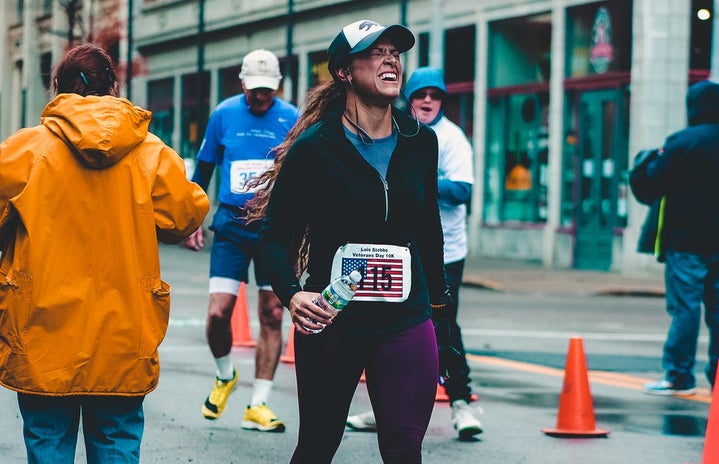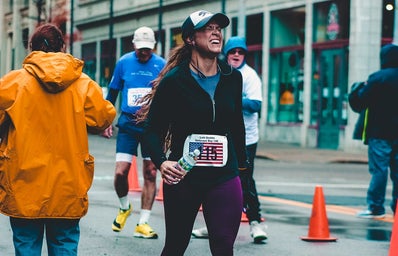It seems like everyone is using this extended (although unwanted) break from everyday life to get in shape and undergo some sort of drastic lifestyle change.
I want to preface by saying that in no way, shape or form do you have to change your life during this time. You don’t have to learn a new skill. You don’t have to be productive. This is a really challenging time, and however you want to spend it is completely valid.
But.
If you find yourself feeling down and you’re looking for a way to stay active, get the heck out of your house for a bit and boost your endorphins, may I introduce to you: running.
Believe it or not, it can actually be fun. The gym class mile in 80-degree-heat when you’re dehydrated and your P.E. teacher is screaming at you from the bleachers does not, exactly, do this sport justice. I know it might feel overwhelming or scary, but the best part about running is that anyone can do it. Lace up, kick back and let me be your guide into the world of miles and smiles (OK, and the occasional grimace. But mostly smiles.)
Step 1: Gear up.
You can not run in your Nike tennis shoes from the eighth grade. Invest in yourself, and you will be more likely to want to gear up and get out there! Nike does make some great shoes, but if you find yourself needing extra foot support, I’ve had tons of luck with Asics, Saucony and Hoka. Go to their websites, read up and find a pair that works for you. And that’s really all there is to it. No machine. No weights. Just some shoes. Simple enough.
Step 2: Fuel.
Starving yourself so you don’t get a cramp: stupid. Not drinking the night before and then planning to hit the road and do great things the next day: stupid. Food and water are essential parts of being a runner. You really just have to find what works for you. I can’t eat within two hours of going on a run, but I need to be sipping water until the minute I head out the door. The meal you eat before running should have carbs, protein, and healthy fat to keep you satisfied and to give you the proper stores to power through a tough workout. Play with different combos and find what makes you feel good. Toast or a banana with peanut butter, oatmeal, an energy bar, a bag of nuts…any and all of these things are sure to help you avoid hitting a wall, while not over-stuffing you and making you uncomfortable. If you find these things too heavy, a small pack of fruit snacks or some easily digestible crackers (I recommend Goldfish) can do the trick and are absolute godsends.
Even if you’re running to lose weight, you still need to eat.
And if you don’t, you won’t be running for long before you burn out, get injured and have to give up on that plan in the first place.
Step 3: Be reasonable.
So you ran a seven minute mile in middle school, and now you think you can run three miles in 21 minutes, because that’s just math, baby.
Actually, it isn’t.
You aren’t going to be able to go out and hit a mile personal record, and then just keep running. Endurance takes metabolic and cardiovascular training and works entirely separate muscle groups from speed. Your distance runs, to start, should be anywhere from one to two minutes slower than your best recent mile time. That means that if you’ve run a seven-minute mile, nine-minute pace is a great place to start working up your mileage.
Step 4: Pick a goal and pick a plan.
Lots of people find that in order to feel motivated to start running, they need to have a set goal in mind. Sign up for a local race, or even hit a virtual course (Nike Run Club’s app has some great ones!) so that you always have your eyes on the finish line. Think about a distance that feels reasonable for you (I would recommend a 5K, if you’re completely new to this!) and then find a training plan to follow. Runner’s World has a great list of training plans for any experience level and any goal distance, if you don’t know where to start.
Step 5: Find a way to track yourself.
If you don’t want to invest in a watch, Nike Run Club is a fantastic app to use when you’re starting out running. You can set goals, save your past runs to compare progress and even opt for guided runs with professional coaches which will help you regulate your pace. You can listen to your music while using the app, which is a major bonus!
Step 6: The Actual Running Part.
So you bought the shoes, you found a plan, you ate right, you downloaded the app. And now you’re sweating up an anxious storm before even hitting the road. Here are some tips to help put your mind at ease and maybe—just maybe—have some fun while you’re at it.
-
Guided runs! Like I said before, Nike Run Club is fantastic and will keep you company while also hyping you up and making you feel like the badass you are.
-
Music! Make a playlist with songs that you know the words to. Focus on the lyrics as you run; your brain will take some focus off any discomfort and funnel it into that!
-
Look ahead! This one sounds silly, but I promise it works. Pick a point about 100 meters ahead of you, like a mailbox or a tree. Train your eyes on that point and “reel it in.” This keeps you in the zone, and breaks down your run so it feels less overwhelming.
-
Let go of expectations! You might go out hoping to run two miles, and barely make it through one. That is okay. You’re new to this, you’re trying, and I promise that you will never regret listening to your body. Try to hit the sweet spot between a pushing effort and conscientiousness. You should be uncomfortable, but you shouldn’t necessarily be in pain.
-
Use your arms! I see so many people running with their arms at their sides, and that makes it so much harder on you. Double your momentum by swinging your wrists from ear to pocket, making a wide gate with your elbow. Running is so much more than just your legs. You have got to swing your arms, especially on uphills, if you want to get full benefits (and to feel better overall).
Step 7: Recovery.
Important, but often overlooked. You should aim to stretch for about 10 minutes after each run, or you’ll be feeling it more the next day—this is a great stretching routine, if you’re not sure where to start. Drawing the letters of the alphabet by rotating your ankles is another way to loosen up and prevent injury. Leg swings should actually be done before and after the run to keep your legs fluid and functioning. And, if you’re still feeling that lactic acid, lie on your back and stick your legs up against a wall for a while to aid in drainage.
Most importantly, again, is food and water. Yes, water. None of that Gatorade nonsense (unless it was very hot or very intense—and even if that was the case, you should be drinking water right alongside it). And absolutely no Bang energy.
Step 8: Injury prevention.
Wear the right shoes. Cross train at least once a week, on a bike, elliptical, rowing machine, or any other sort of cardio equipment to give your feet and legs a break. Strength train (yes, Chloe Ting is fantastic!) to build your muscles and joints and help in impact absorption. And take a day or two off each week to let yourself recover.
You’ve got this. Now go get it!


